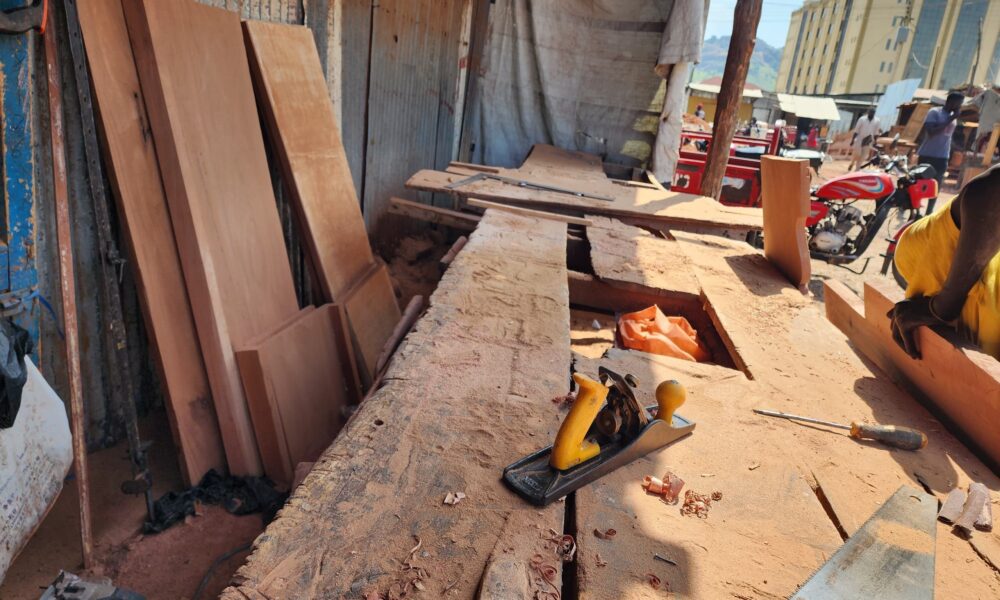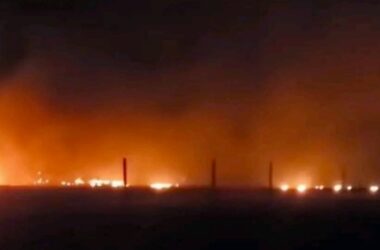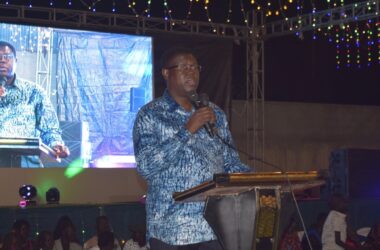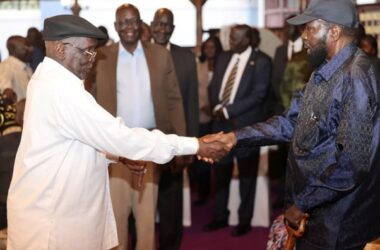By Philip Buda Ladu/Julie Londo
Stepping into Juba’s open-air timber market under the blazing sun, you’re immediately struck by the sheer volume of Congolese and South Sudanese wood.
Along dusty streets, simple shops made of rusting corrugated iron are stacked high with mahogany and teak, their freshly sawn faces gleaming in the light and revealing rugged, rune-like grains.
The market pulses with energy, especially at Jebel Market on the Nile’s west bank–the trade’s bustling heart. Diesel-powered saws roar as men shout over the din, machetes slice through bark, and chainsaws kick up shimmering clouds of sawdust. Trucks and rickshaws groan under heavy loads, stirring red dust that settles over everything.
The air is thick with the scent of raw wood, mixed with smoke from roadside grills, machine oil, and the earthy damp of aging planks. Occasionally, the aroma of grilled maize or roasted meat drifts by–a reminder that this is also a place of daily life and sustenance.
Nearby, polished hardwood beds, chairs, and tables line the streets, proudly showcasing the transformation of raw logs into finely crafted furniture.

Some of the neatly crafted and well-polished hardwood beds along Juba’s Jebel market streets the epicenter of the timber market (Photo: Philip Buda Ladu)
What is starkly clear is a remarkable difference between Democratic Republic of Congo (DRC) wood and local South Sudan wood.
Mohammad Bhari, a carpenter who has been operating in Juba since the country got independence, says. “The primary distinction lies in the maturity and measurement. Locally sourced hardwood (Mahogany) is generally shorter, while timber from the DRC is notably longer.”
“The quality of DRC timber is consistently high, characterized by uniform size and measurement. We utilize both types of timber, selecting based on quality regardless of origin,” he adds.
The illegal trade

A timber trader offloads and file his new stock of Mahogany hardwood timber in Juba’s market (Photo: Supplied)
Due to its quality and quality furniture made from it, it’s the reason timber shops pay a premium price for trucks to ferry it thousands of miles from DRC, sometimes going through Uganda to Juba. And much of this timber is harvested illegally, government officials in South Sudan admit.
“One of the things is that most of this timber if they come, they come from the illegal sources in the DRC,” Jaden Tongun Emilio, the Under Secretary for Forestry in the South Sudan Ministry of Environment and Forestry says in an interview.
Apart from timber coming from illegal sources, Tongun says, it can also be easily smuggled into the country. “The border between South Sudan and DRC is so wide that, you know, you can infiltrate, you can bring your goods into the country illegally, and not even through the official border” Mr. Tongun painted a grim picture of the trade,” he says.
Timber deals in Juba like Jamal Rasid, a Ugandan national, has worked at a carpentry joinery workshop in Juba’s Jebel Market since 2022 can hardly tell how Congolese timber he uses gets to South Sudan.
“We just normally buy from these people (timber sellers) at their stores, but I don’t know where they bring them from,” Rasid says. His only complaint and that of many others is that timber is getting expensive. Before timber was cheap, but right now it’s very expensive and it’s charged according to the size. Prices range from $14.3 to $4, something traders say is expensive.
“Our major problem is the increase in timber prices. We buy timber with South Sudan pounds but the high dollar rate has increased the prices,” says John Dominic Lado, a South Sudanese carpenter at Jebel Market, who has been in the industry since the early 1990s.
According to Lado, timber from the Democratic Republic of Congo began entering South Sudan’s market as early as the 1980s, during the 21-year liberation war when Sudan was still one country. He explained that logs were transported along the Yei-Juba route, then shipped north to Khartoum, while some remained for local use in Juba.

Piles of DR Congo timbers harvested at the Haut-Uele province ready for import to the market in South Sudan and the region (Photo: Julie London)
How Congo timber gets to Juba?

From DRC to South Sudan, timber takes many routes which have been changing for years. The change in routes is informed by factors such as ease to smuggle, bribe customs officials, acquire documents and state of roads. Timber can either cross directly from DRC to South Sudan or pass through Uganda, traders interviewed say.
A timber trader in Yei, a province that lies on the DRC–South Sudan border, described how timber makes its way to Juba. Mostly, Congolese timber comes without documents–and the lack of proper documentation and other logistical challenges have pushed the business underground.
Before the 2013 war, timber from the DRC entered South Sudan primarily through the border town of Aba, with proper clearance on both sides, including at the Libogo checkpoint in Yei River County. However, this system has since collapsed due to insecurity.
“The official clearance process no longer exists,” says the trader. “Technically, we are bringing forestry products into South Sudan illegally. By law, traders are supposed to receive a Form 15 as proof of payment to the revenue authority. But if you ask anyone in the business today, they won’t be able to show you that form.”
With a clearing system, traders have freedom to negotiate entry of timber without documents or paying taxes in full amounts. A truck would pay between $300 to $400 in taxes, previously but now, there’s no fixed rate–you just pay whatever amount you can, maybe $200 or $300, as long as you can negotiate with the authorities at customs,” the trader says.
The frequent disruptions on the Aba-Yei-Lainya-Juba route has pushed some traders to start using an alternative path through Uganda, at a border point called Birijako, situated close to the border shared by Uganda, DRC and South Sudan.
“Many traders now avoid the usual route because of excessive checkpoints,” John said. “Instead, they take the Birijako route, which follows a different set of procedures.
At Birijako loggers and traders both Congolese and Ugandans transport the timber to the border, where they find South Sudanese customers who select what they need, make payments, and receive documents. “They then enter Uganda, get an exit form, pay a $350 transit fee for a 78-ton truck, and proceed to Nimule. There, they pay an additional fee–maybe $50 or $100–before continuing to Juba.”
Noel Moro, a Tariff Officer with the South Sudan Revenue Authority (SSRA) at the headquarters in Juba, said that Congolese timber is imported into South Sudan through the Nimule-Elegu border, transiting via Uganda.
Daniel Deng, Chairperson of the South Sudan Freight and Forwarders Association (SSFFA) also said timber imports into South Sudan are legally cleared through the Nimule-Elegu border.
“On our side, yes, it’s formal. But in Uganda, they sometimes don’t allow their timber to be exported outside the country. However, if it is in transit, there is no problem. The transit through Uganda to South Sudan is allowed,” Deng explained.
He described the import process, stating that when timber arrives at the border, a clearing agent handles the necessary procedures in the same way as for other goods.
“There are no restrictions on our side,” he said. “You clear with customs, comply with the natural standards group, and if you have an import license from the Ministry of Trade, they apply the standard duty rate. If you don’t have a license, you are subject to a penalty.”
Deng clarified that the penalty for lacking an import license is 80% of the CIF (Cost, Insurance, and Freight) value of the goods.
He added that timber imports must include a commercial invoice, a certificate of origin, an export certificate from the country of origin, and a packing list.
Deng emphasized that whether timber is sourced from Uganda or transits through Uganda, it arrives legally, is properly cleared, and is accepted by border authorities.
From DRC to South Sudan
Most of the timber transported from the Democratic Republic of Congo (DRC) to South Sudan originates in Haut-Uele province, according to Alphonse Sindoni, coordinator of civil society in Dungu territory.
Haut-Uele is already experiencing the effects of sustained logging.
According to Global Forest Watch, between 2002 and 2023, Dungu–a key area in the province–lost 27.6 kha of primary rainforest, accounting for 18% of its total tree cover loss over that period. The total area of primary rainforest in Dungu shrank by 6.9%. In Faradje, 1.32 kha of primary rainforest was lost, representing 1.1% of its total tree cover loss, and a 10% decline in its primary forest area.

Widespread deforestation, especially in areas like the Haut-Uele province, leads to problems for everyone, not just the local people. Forests act like giant sponges that absorb the world’s carbon pollution.
When forests are cut down, it means there are less trees to absorb the world’s increasing carbon pollution. Subsequently carbon is released back into the atmosphere. This worsens climate change which manifests into more extreme weather events, such as droughts and floods among others.
Also, such forests are home to a variety of wildlife, such as African great apes and plants, many of which are unique to these ecosystems. Cutting down trees would mean destroying their habitats, which puts them at risk of disappearing forever. This, in turn, disrupts the balance of nature that sustains the planet’s health.
Beyond the environmental impact, extensive deforestation directly affects the communities living in and around these forests. Many communities depend on the forests for their livelihoods, whether for food, medicine, or materials for their homes. When the forests vanish, these resources disappear, making life more challenging for already vulnerable populations. This can also lead to increased conflicts over dwindling land and resources and even force people to relocate from their traditional homes.
Both Dungu and Faradje border Garamba National Park, have faced persistent illegal logging for years.
Richard Kalayi, Communications Officer at Garamba National Park, emphasized that forest resource exploitation within the Garamba complex is strictly regulated. While logging is allowed for local use, it must follow specific guidelines. Kalayi stressed that no timber from the complex has ever been exported to East African countries.
“I must clarify one thing: there is no logging in Garamba National Park itself, because even unauthorized presence in the park is an offense,” he said. “However, the Garamba complex includes four protected areas; the park itself, and the Gangala na Bodio, Mondomisa, and Azande hunting areas. Regulated logging is only permitted in these hunting zones.”
Kalayi explained that logging is allowed for personal use. “If a community member wants to build a house, they don’t need authorization. But if they want to produce rafters or planks, they must submit a request to the customary chief,” he added.
Vincent Sindano, head of the environmental department in the Dungu territorial branch, also noted that logging around Garamba is primarily for domestic purposes. “There is no large-scale logging in Dungu territory; locals use timber for charcoal, construction, and furniture. In Sambia, the ICCN allowed logging only to meet basic needs,” he said.
But Alphonse Bady Ngome, civil society coordinator for Dungu territory, offered a different perspective. He confirmed that, beyond local use, large volumes of timber are being extracted from Haut-Uele and sent to South Sudan.
“Yes, locals use the wood for domestic purposes, but a significant portion leaves Haut-Uele for South Sudan. Due to this ongoing trade, the ICCN revoked exploitation rights in Sambia. Some residents were exporting timber,” Ngome said.
Timber moves through several localities, including Dungu, Nakofo, Li May, Kiliwa, Kpaika, Nambili, Babele, Nambia, Duru, and Bitima. Ngome raised these issues in the context of rising deforestation in northern Haut-Uele.
Much of the illegally logged timber passes through Uganda before reaching South Sudan. It travels via Aru in Ituri province, crosses into northern Uganda, and exits through the Elegu border. Additional timber from Ituri also enters Uganda through the Kasindi–Lubirigha checkpoint and follows a similar route to South Sudan.
This trade continues despite an official logging ban in the DRC. In July 2021, Environment Minister Ève Bazaïba introduced deforestation control measures, including a moratorium on timber exports. Since then, all export permits have been suspended, meaning no timber should legally leave the country.
However, exporters have found workarounds. Instead of traditional permits–no longer issued under COP27 regulations–they now rely on a document called the Note de Début. This allows them to navigate administrative procedures and continue international shipments.
One exporter from Beni said the system lacks oversight:
“We’re not the ones encouraging fraud, if it even is fraud. The government facilitates it. They give us a phone number, and we’re told where to deposit money. Once paid, we receive a Note de Début and a receipt. These documents are accepted without issue by all border officials,” the exporter said.
This story was supported by InfoNile in partnership with Global Forest Watch.




